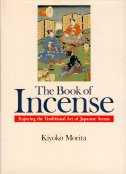
Book
Reviews
Book 21
By Kiyoko Morita

Pub. Kodansha International Tokyo 1992
ISBN 4-7700-1557-7
This small 134 page book describes and explores the Way of Incense – the
Ko-doh, or the Japanese and their cult of “listening to incense” – a
concept imported from China when dealing with faint & subtle odour aspects-
rather than smelling it. As Japan possessed few aromatic spices and incense wood
these ingredient materials had to be imported from SE Asia or further afield.
Not mentioned in the book is that demand for incense materials such as
sandalwood in the 19th Century resulted in its plundering from many
Pacific Islands and the spilling of much Melanesian blood.
Somehow the loss of human life involved in the procurement of materials
destined to be used merely for ritual and ceremonial purposes did not seem to
prevent its continued use in the name of Buddhism.
Seventeen main ingredients of Japanese incense (Koh) are illustrated in a
double page spread near the beginning of the book, and include more familiar
materials such as sandalwood, aloeswood, Borneo camphor, frankincense, benzoin,
myrrh, cloves, patchouli, cassia, cinnamon etc. Some less familiar materials are
also illustrated – such as haiso-koh. As the author cites the Shoyeido
Corporation for advice & support during the writing of the book, if we turn
to the Corporate website page for
Shoyeido http://www.holograms.bc.ca/incense/secrets.html
we see haiso-koh is identified there as deriving from Agastache rugoa. Other
ingredients are revealed as re-ryokoh (tonka bean), kansho (spikenard),
karra-mokkoh (Saussurea – presumably the endangered Costus plant - Saussurea
lappa?). We are told by the author that musk from the abdominal sacs of musk
deer, and ambergris from certain whale species, at least, are no longer used in
modern Japanese incense, although the other scarce ingredients (aloeswood,
sandalwood, costus) presumably still continue to be employed.
These objections apart, Kiyoto Morita goes on to describe the Way of Incense
and its relationship to Japanese literature and poetry. The early
interrelationship of incense and Buddhism and the birth of Koh-do with shogun
Ashikaga Yoshimasa are explained together with the merits/demerits of burning of
jinkoh-wood qualities vs. blended incense. Incense appreciation with its rules
and customs and associated paraphernalia became more widespread, and the status
& legitimacy of incense schools and associated expertise became pretty much
part of a hierarchical system, which eventually waned, but has undergone a small
revival of late.
The author goes on to describe the varieties of Japanese incense including
the six categories of jinkoh-wood and the various incense products (incense
balls, joss-sticks, cones and sachets). Much of the rest of the book covers the
art of appreciation of Japanese incense and a detailed account of the art of
appreciation/games played during these ceremonies. As a contemporary piece of
research into the subject the account is probably second to none – however I
found it less than fascinating.
I can recommend this book to those who are intrigued by Koh-doh and can
easily find themselves immersed in another culture. For me it is a glimpse into
the Japanese incense tradition, which itself is a small shard in the much bigger
crystal of aromatic plant use.
Copyright Tony Burfield 2004